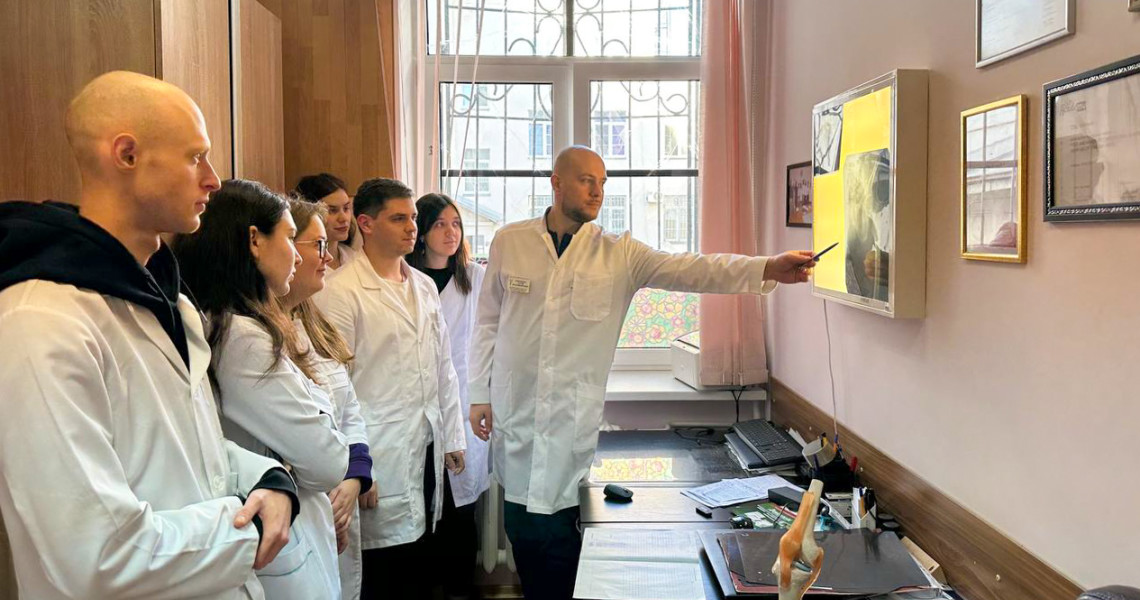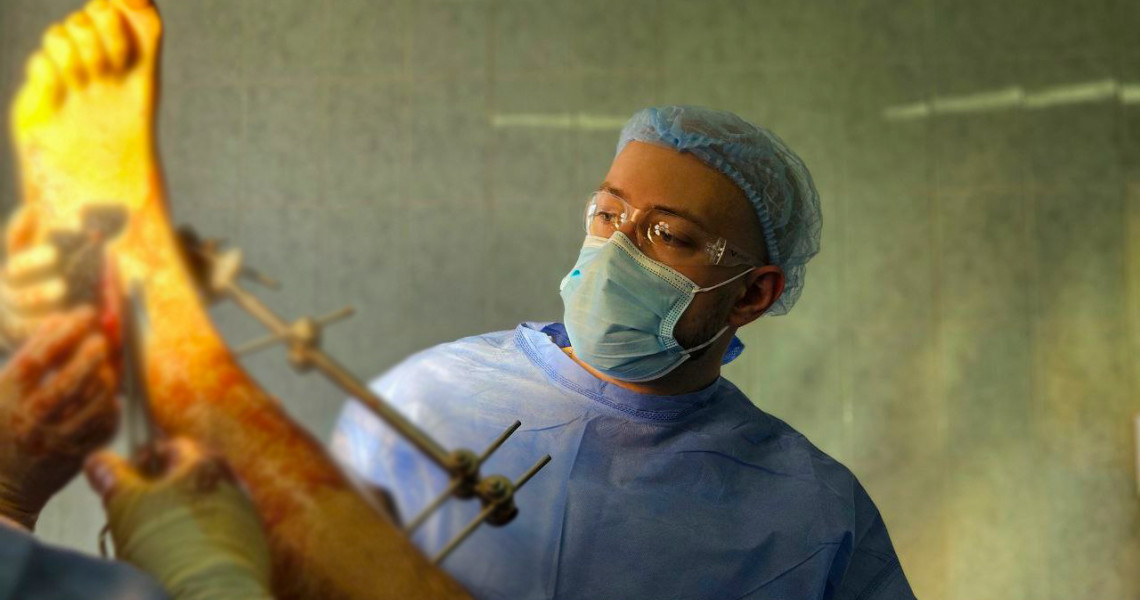У Всесвітній день травматолога до вашої уваги - інтерв`ю лікарем-ортопедом, травматологом, доктором філософії, доцентом кафедри хірургії №3 Полтавського державного медичного університету Сергієм Кононенком.
У відвертій і фаховій розмові йшлося не лише про переломи та гіпси, а й про бажання людини бути сильнішою, долати виклики в умовах війни, роль симуляційного навчання, а також про те, як наші щоденні звички можуть або зберегти, або зруйнувати здоров’я.
– Пане Сергію, як Ви вважаєте, люди частіше травмуються через необережність чи через прагнення бути супергероями?
Найчастіше ці речі поєднуються. Найнебезпечнішими є ті дрібниці, на які ми не зважаємо. Це поспіх, телефон у руках, неуважність, нехтування технікою безпеки вдома чи на роботі. Люди йдуть слизькими сходами в темряві, не тримаючись за поручень, бо «поспішають». Або ж відкривають вікна, стоячи на крайках стільців — «бо я ж швидко». І в одну мить — серйозна травма.
А тепер додайте до цього так званий «синдром супергероя». Хтось у 60 років вирішує пробігти марафон, бо «колись бігав». Інший сам встановлює кондиціонер, стоячи на підвіконні без страховки — бо «невже я не зможу?». Молодь теж ризикує: надивившись відео фітнес-блогерів, беруться за важкі вправи без належної техніки — і травмуються.
Це не лише про бажання вразити інших. Часто це — неусвідомлене прагнення довести щось самому собі, що що ти ще можеш, що ти сильний. І саме в цьому моменті, коли бажання накладається на необережність або нестачу досвіду, виникає травма.
– Які травми найпоширеніші останнім часом у Полтаві та області?
Найчастіше — це переломи кінцівок, особливо взимку. Типові випадки — переломи променевої кістки, гомілки, ключиці. Також звертаються з вивихами, забоями, спортивними травмами. Багато травм спричиняють ДТП. У літніх людей через остеопороз навіть незначні падіння можуть завершитись переломом шийки стегна.
– Чи завжди гіпс — найкращий варіант при переломах пальців?
Не обов’язково. Існують зручніші альтернативи, це термопластичні ортези, шини — вони гігієнічніші та менше обмежують побутову активність. Все залежить від характеру травми.
– Що Ви порадите українцям для профілактики травм у побуті та спорті?
Основне — дбати про безпеку як про звичку:
- носіть зручне, ортопедичне, не слизьке взуття;
- будьте уважними на слизьких поверхнях, не поспішайте;
- освітлюйте під’їзди;
- не зберігайте важкі предмети на верхніх полицях;
- людям похилого віку — користуватися тростинами або ортопедичними засобами.
У спорті:
- обов’язково виконуйте розминку;
- правильно опановуйте техніку під наглядом фахівця;
- не перевантажуйте себе;
- використовуйте належне екіпірування;
- звертайте увагу на сигнали тіла: біль, набряк — це привід звернутися до лікаря.
– Чому захворювання суглобів в Україні стають поширеними навіть серед молоді?
Це відбувається через малорухливий спосіб життя, неправильне харчування, надмірні фізичні навантаження, травми, аутоімунні процеси. Профілактика — це контроль ваги, зниження вживання цукру і глютену, щоденна рухова активність, своєчасна діагностика.
– Як ПДМУ готує студентів до реальних викликів у травматології?
У ПДМУ студент отримує комплекс знань - від анатомії до біохімії процесів травми. Навчання включає семінари, клінічні розбори, моделювання надзвичайних ситуацій у симуляційному центрі. Тут студенти вчаться накладати шини, вводити ін’єкції, діяти в умовах ДТП чи політравми — це формує швидкість і точність рішень.
– Яку роль відіграє в університеті симуляційне навчання?
Ключову. Це безпечне середовище для формування навичок, без ризику для пацієнта. Студенти можуть помилятися, аналізувати, вдосконалюватись. Також це сприяє командній взаємодії й розвитку технічної майстерності.
– Якими рисами, на вашу думку, має володіти майбутній травматолог?
Насамперед це рішучість, витривалість, холодний розум, здатність швидко приймати рішення. Важлива також професійна майстерність, фізична форма і, звісно, бажання допомагати. Наставництво — важливий елемент мотивації.
– Які виклики сьогодні стоять перед українською травматологією?
Основний — війна, яка породжує нові типи травм і потребує гнучкості, сучасних методів, відновлення. Водночас це поштовх до розвитку: мінімально інвазивна хірургія, біоінженерія, 3D-друк, створення кісток зі стовбурових клітин — усе це вже не фантастика.
– Чи доступні сучасні методи лікування травм в Україні?
Так. Артроскопія, ендопротезування, сучасне обладнання — усе це є. І наші лікарі володіють цими методиками.
– З чого виготовляють протези, і чи завжди ціна відповідає якості?
Протези виготовляють із високотехнологічних матеріалів, які поєднують легкість, міцність, зносостійкість і безпеку для контакту з тілом людини. Матеріали — титанові, алюмінієві сплави, карбон, спеціальні полімери. Карбонові — легкі та міцні, але дорогі. Проте не завжди найдорожче — найкраще. Ідеальний протез — індивідуально підібраний, зручний, з належною реабілітацією.
– А як щодо збору кришечок на протези?
Самі кришечки не йдуть на виготовлення протезів напряму, але кошти від їхньої переробки — так. На ці гроші купують протези, фінансують реабілітацію дітей та військових. Це добрий приклад, як дрібниці рятують життя.
– І наостанок — кілька порад нашим читачам?
Будьте уважні у побуті, транспорті, під час спорту. Не ігноруйте біль чи набряки. Адже своєчасне звернення до лікаря — це запорука відновлення. І найголовніше: травматологія — це не про поламані кістки, а про повернення до повноцінного життя.
Робота лікаря-травматолога — це поєднання витривалості, точності, глибоких знань і людяності. Інтерв’ю з доцентом Сергієм Кононенком — ще одне підтвердження, що в Полтавському державному медичному університеті готують не лише висококласних фахівців, а й людей, готових щодня повертати іншим здоров’я, рух і надію.
Прес-служба Полтавського державного медичного університету
Inside Traumatology: Profession, Challenges, and Meaning — An Interview with Dr. Serhii Kononenko, PhD and Associate Professor of the Department of Surgery No. 3 at PSMU
On World Traumatologist Day, we bring you an interview with Dr. Serhii Kononenko, the orthopedic surgeon and traumatologist, PhD, and Associate Professor of the Department of Surgery No. 3 at Poltava State Medical University.
In this candid and professional conversation, we spoke not only about fractures and casts, but also about the human desire to be stronger, to overcome challenges during wartime, the role of simulation-based learning, and how our everyday habits can either preserve or destroy our health.
– Mr. Serhii, in your opinion, do people get injured more often due to carelessness or trying to be superheroes?
These things are usually intertwined. The most dangerous are the small details we ignore — being in a hurry, holding a phone, inattention, neglecting safety measures at home or at work. People walk down slippery stairs in the dark without holding the railing because they are “in a rush.” Or they open windows while standing on the edge of a chair — “I'll be quick.” And in one moment — a serious injury.
Then add the so-called "superhero syndrome." Someone at 60 decides to run a marathon because they "used to run." Another person installs an air conditioner while standing on a windowsill without any safety gear — because “of course I can do it.” Young people also take risks: after watching fitness bloggers, they start doing heavy workouts without proper technique — and end up injured.
It’s not just about impressing others. Often, it’s an unconscious need to prove something to oneself — that you still can, that you're strong. And exactly at that point, when desire meets carelessness or lack of experience, injuries occur.
– What are the most common injuries in Poltava and the region lately?
Most often — limb fractures, especially in winter. Typical cases include fractures of the radius, tibia, clavicle. We also treat dislocations, contusions, and sports injuries. Many injuries are caused by traffic accidents. Among the elderly, even minor falls can result in hip fractures due to osteoporosis.
– Is a cast always the best option for finger fractures?
Not necessarily. There are more convenient alternatives — thermoplastic orthoses, splints — they are more hygienic and less restrictive of daily activity. It all depends on the nature of the injury.
– What would you advise Ukrainians to prevent injuries at home and during sports?
The key is o treat safety as a habit:
- wear comfortable, orthopedic, non-slippery shoes;
- be cautious on slippery surfaces, don’t rush;
- ensure proper lighting in stairwells;
- avoid storing heavy items on high shelves;
- elderly people should use canes or orthopedic aids.
In sports:
- always warm up properly;
- learn technique under expert supervision;
- avoid overloading yourself;
- use proper equipment;
- listen to your body — pain or swelling are signals to consult a doctor.
– Why are joint diseases becoming common even among young people in Ukraine?
This is due to a sedentary lifestyle, poor nutrition, excessive physical strain, trauma, and autoimmune processes. Prevention includes weight control, reducing sugar and gluten intake, daily physical activity, and timely diagnosis.
– How does PSMU prepare students for real-life challenges in traumatology?
At PSMU, students receive comprehensive knowledge — from anatomy to the biochemistry of trauma. Training includes seminars, clinical case studies, and emergency simulations in the simulation center. There, students learn how to apply splints, give injections, and act in situations like car accidents or polytrauma — this builds decision-making speed and accuracy.
– What role does simulation-based learning play at the university?
A crucial one. It provides a safe environment for developing skills without risking patient safety. Students can make mistakes, reflect on them, and improve. It also promotes teamwork and technical proficiency.
– In your opinion, what qualities should a future traumatologist possess?
Above all: decisiveness, endurance, a calm and focused mind, and the ability to make quick decisions. Also essential are professional skill, physical fitness, and, of course, a desire to help. Mentorship is an important element of motivation.
– What are the main challenges facing Ukrainian traumatology today?
The biggest one is the war, which brings new types of injuries and demands adaptability, modern methods, and rehabilitation. At the same time, it’s driving innovation: minimally invasive surgery, bioengineering, 3D printing, and creating bones from stem cells — all of this is no longer science fiction.
– Are modern methods of injury treatment available in Ukraine?
Yes. Arthroscopy, joint replacement, and advanced equipment are available. And our doctors are well-versed in these techniques.
– What are prosthetics made from, and does the price always reflect the quality?
Prosthetics are made from high-tech materials that are lightweight, durable, wear-resistant, and safe for contact with the human body. Materials include titanium, aluminum alloys, carbon fiber, and specialized polymers. Carbon fiber is light and strong, but expensive. However, the most expensive isn’t always the best. The ideal prosthesis is individually selected, comfortable, and accompanied by proper rehabilitation.
– What about collecting plastic caps for prosthetics?
The caps themselves aren’t directly used to make prosthetics, but the funds from recycling them are. These funds are used to purchase prosthetics and finance rehabilitation for children and soldiers. It’s a great example of how small things can save lives.
– And finally, a few tips for our readers?
Be cautious at home, in transport, and during sports. Don’t ignore pain or swelling — timely medical attention is key to recovery. And most importantly: traumatology isn’t just about broken bones — it’s about restoring full lives.
The work of a traumatologist is a blend of endurance, precision, deep knowledge, and compassion. This interview with Associate Professor Serhii Kononenko is yet another confirmation that Poltava State Medical University trains not only top-level professionals but also people who are ready every day to restore health, mobility, and hope.








